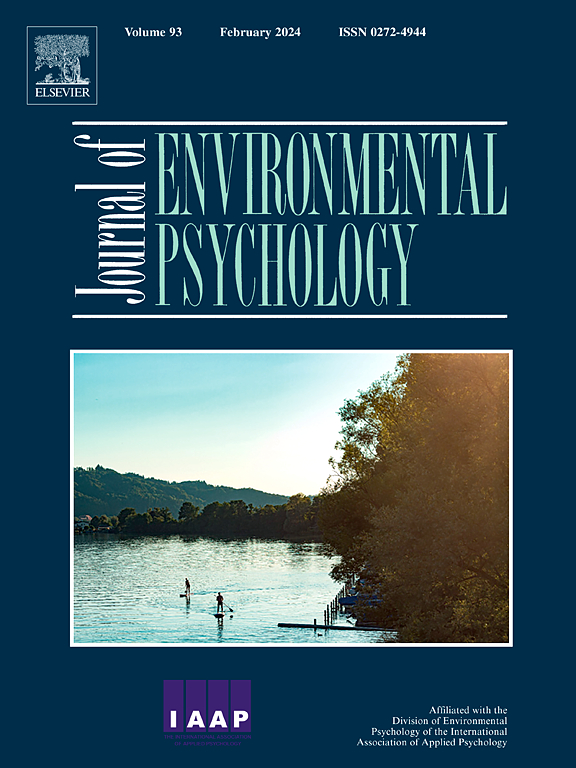利用 360° VR,研究在城市或自然环境中从认知和噪音引起的短期压力积累到恢复的效应链
IF 7
1区 心理学
Q1 ENVIRONMENTAL STUDIES
引用次数: 0
摘要
人口增长和城市化进程的加快导致人们越来越多地暴露在交通噪音中,同时也导致可利用的绿地减少,而绿地可以促进人们从噪音引起的压力中恢复过来。这项虚拟现实实验室研究的目的是调查噪声和认知需求链对短期压力积累的影响,以及随后在自然绿地或城市建筑安静空间中恢复压力的情况。参与者首先暴露在不同声压级(LAeq 为 35、55 或 75 dB)的道路交通噪音中,然后被随机分配到被动聆听(认知需求低)或同时执行认知需求高的任务(需求高)。压力阶段显示,高要求组的感知压力和强直性皮肤传导水平高于低要求组,这与噪音暴露无关。噪声暴露的增加与噪声烦扰等级的升高和自我评估的降低有关。在随后的恢复阶段,所有感知恢复的指标都表明,绿色空间比非绿色空间具有明显优势。此外,与城市建筑空间的参与者相比,沉浸在绿色恢复空间中的高需求组参与者的皮肤电导水平明显较低。研究结果表明,在噪音和认知需求引起的短期压力下,置身于自然绿地有利于心理和生理的恢复。我们的研究强调了城市绿地的重要有益作用,尤其是在人口稠密、噪音较大的城市环境中。本文章由计算机程序翻译,如有差异,请以英文原文为准。
Investigating effect chains from cognitive and noise-induced short-term stress build-up to restoration in an urban or nature setting using 360° VR
Population growth and increasing urbanization leads to growing exposure to traffic noise and a decline in accessible green spaces that could promote restoration from noise-induced stress. The objective of this virtual reality laboratory study was to investigate the effect chains of noise and cognitive demand on the build-up of short-term stress, and subsequent restoration in either a natural green or urban built quiet space. Participants were first exposed to road traffic noise of different sound pressure levels (LAeq of 35, 55, or 75 dB), being randomly assigned to passive listening (low cognitive demand) or concurrently performing cognitively demanding tasks (high demand). The stress phase revealed higher levels of perceived stress as well as tonic skin conductance for the high demand over the low demand group, independent of noise exposure. Increasing noise exposure was associated with elevated noise annoyance ratings and lower self-assessed wellbeing. In the subsequent restoration phase, all measures of perceived restoration indicated a clear advantage for green over non-green spaces. Further, participants from the high-demand group who were immersed in the green restorative space displayed significantly lower skin conductance levels than those in the urban built spaces. The findings suggest that exposure to natural green spaces is beneficial for psychological as well as physiological restoration from short-term stress induced by noise and cognitive demand. Our study underlines the important beneficial role of urban green spaces, particularly in densely populated, noisy urban environments.
求助全文
通过发布文献求助,成功后即可免费获取论文全文。
去求助
来源期刊

Journal of Environmental Psychology
Multiple-
CiteScore
10.60
自引率
8.70%
发文量
140
审稿时长
62 days
期刊介绍:
The Journal of Environmental Psychology is the premier journal in the field, serving individuals in a wide range of disciplines who have an interest in the scientific study of the transactions and interrelationships between people and their surroundings (including built, social, natural and virtual environments, the use and abuse of nature and natural resources, and sustainability-related behavior). The journal publishes internationally contributed empirical studies and reviews of research on these topics that advance new insights. As an important forum for the field, the journal publishes some of the most influential papers in the discipline that reflect the scientific development of environmental psychology. Contributions on theoretical, methodological, and practical aspects of all human-environment interactions are welcome, along with innovative or interdisciplinary approaches that have a psychological emphasis. Research areas include: •Psychological and behavioral aspects of people and nature •Cognitive mapping, spatial cognition and wayfinding •Ecological consequences of human actions •Theories of place, place attachment, and place identity •Environmental risks and hazards: perception, behavior, and management •Perception and evaluation of buildings and natural landscapes •Effects of physical and natural settings on human cognition and health •Theories of proenvironmental behavior, norms, attitudes, and personality •Psychology of sustainability and climate change •Psychological aspects of resource management and crises •Social use of space: crowding, privacy, territoriality, personal space •Design of, and experiences related to, the physical aspects of workplaces, schools, residences, public buildings and public space
 求助内容:
求助内容: 应助结果提醒方式:
应助结果提醒方式:


